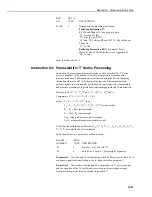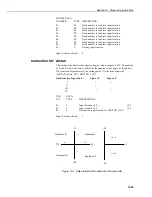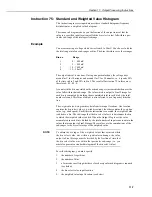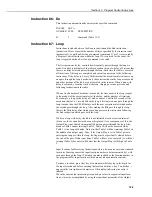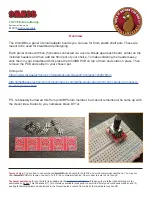
CR10X Reference Manual
11-8
6.
the lower range limit
7.
the upper range limit
The standard histogram (frequency distribution) is specified by entering ‘0’ in the
weighted value input location parameter. Otherwise, this parameter specifies the
input location of the weighted value. When more than one repetition is called for,
the bin select value location is incremented with each repetition and the weighted
value location remains the same (same weighted value sorted on the basis of
different bin select values). The weighted value location is incremented if it is
entered as an indexed location (press ‘
C
’ at some point while keying in parameter
5; two dashes, --, will appear on the right of the display).
The histogram can be either closed or open. The open form includes all values
below the lower range limit in the first bin and all values above the upper range
limit in the last bin. The closed form excludes any values falling outside the
histogram range.
The difference between the closed and open form is shown in the following
example for temperature values:
Lower range limit
10
o
C
Upper range limit
30
o
C
Number of bins
10
Closed Form
Open Form
Range of first bin
10 to 11.99
o
C
<12
o
C
Range of last bin
28 to 29.99
o
C
>28
o
C
A common use of a closed form weighted value histogram is the wind speed rose.
Wind speed values (the weighted value input) are accumulated into corresponding
direction sectors (bin select input).
PARAM.
DATA
NUMBER TYPE
DESCRIPTION
01:
2
Repetitions
02:
4
Number of bins
03:
2
Form code (0=open form, 1=closed form)
04:
4
Bin select value input location no.
05:
4
Weighted value input location no. (0 = frequency
distribution option)
06:
FP
Lower limit of range
07:
FP
Upper limit of range
Outputs Generated: Number of Bins * Repetitions
Instruction 77: Record Real Time
This instruction stores the current time in Final Storage. At midnight the time
changes from 23:59 to 00:00. The day also changes.
If hourly or daily summary data is output, it may be desirable to have the previous
day output, since that is when the measurements were made. Entering ‘2’ for the
day code causes the previous day to be output if it is the first minute of the day.
Similarly, entering ‘2’ for the hour-minute code causes 2400 instead of 0000 to be




